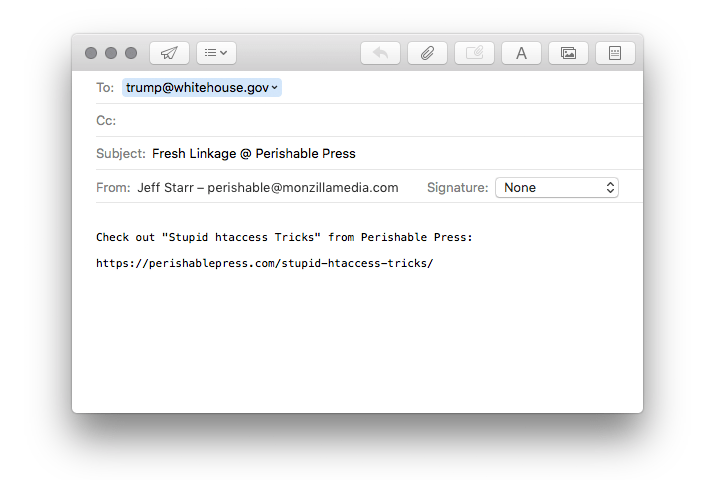Here is my custom list of abbreviations for commonly used terms, as written via HTML’s <abbr></abbr> tag. I’m posting this to make it available to anyone who finds it useful. Very handy when writing tutorials related to WordPress, web design and development. A quick copy/paste is much quicker than typing it all out. Without further ado, here is my “cheat sheet” of HTML abbreviations. Continue reading »

Typography is inspiring :) I recently posted about all the different HTML “X” characters. Then a tweet from Helge Klein inspired me to write a follow-up post showing all the different ways to write a dash or hyphen – character in HTML. Like most online content creators, I knew about – and —. But I didn’t realize there were so many other hyphen and dash characters. Continue reading »

This post explains all the different “x” characters currently available in HTML. It covers the various HTML entities and provides some examples and tips. Also explains the difference between the often confused “Multiplication X” and “Multiplication Sign”, and which is better for symmetrical buttons and links. Continue reading »
![[ _blank Target Vulnerability ]](https://perishablepress.com/wp/wp-content/images/2019/blank-target-vulnerability.jpg)
In this article, I am reposting part of my recent tutorial, WordPress and the Blank Target Vulnerability. That post is aimed at WordPress specifically, however most of the article applies to HTML in general. So the tutorial below explains how to fix all “blank target” links, regardless of whether or not WordPress is involved. Continue reading »
While working on the site’s 24th redesign, I ended up with about 10 code snippets that were awesome but ultimately not needed. So rather than just delete these tasty functions, I am posting them here for future reference. Who knows, during the next site update I may decide to implement or repurpose some of these techniques. And of course sharing is caring, so feel free to use any of these code snippets in your own projects. Check out the Table […] Continue reading »
![[ WP Visual/RTE Insert Link Dialog ]](https://perishablepress.com/wp/wp-content/images/2018/wp-rte-insert-link.png)
For those who haven’t yet noticed, WordPress now adds rel="noopener" attributes for any external links added via the link Quicktag in the Visual/RTE. So if you enable the option, “Open link in a new tab”, WordPress automatically will add the rel noopener attribute to the link. This is to protect against CORS and other exploits that take advantage of blank-target links. It’s a smart move that may escape many in the WordPress community. So in an effort to help foster […] Continue reading »
![[ RSS Feed Icon ]](https://perishablepress.com/wp/wp-content/images/2011/rss-feed-icon-128.png)
Converting small images to data-URLs is a great way to eliminate HTTP requests and decrease loading time for your pages. Using PHP‘s base64_encode() and base64_decode() functions, we have the power to convert images to data-URLs and vice-versa. This article explains how it all works, and shows some different ways of converting back and forth between original and encoded images. Continue reading »
If you operate a website that features lots of code examples, you know how important it is to spend some quality time styling the <pre></pre> element. When left unstyled, wild <pre></pre> tags will mangle your preformatted content and destroy your site’s layout. Different browsers treat the <pre></pre> tag quite differently, varying greatly in their default handling of font-sizing, scrollbar-rendering, and word-wrapping. Indeed, getting your preformatted code to look consistent, usable, and stylish across browsers is no easy task, but it […] Continue reading »
While browsing the internet these days, I see a lot of this: <body> … <a name="top"></a> … <a href="#top">- Back to Top -</a> … </body> There’s an easier, better and prettier way. CSS Signatures are all the rage these days. If you’re not familiar with a CSS Signature, it’s basically nothing more than an ID on your body tag, like this: <body id="www-domain-tld"></body> The fundamental purpose of the CSS Signature is to allow a user to specify style adjustments to […] Continue reading »
Behold the ubiquitous list elements, <ul></ul> and <ol></ol>! These two sexy elements help millions of websites display lists of information in clean, semantic fashion. Without them, we’d be crawling around like filthy cavemen, eating dirt and howling at the moon. But these list elements aren’t just sexy, they are also extremely flexible, enabling us humble designers to create robust list configurations that are semantically versatile and highly customizable. We all know how to throw down a basic list: Continue reading »
![[ Electrical Surge ]](https://perishablepress.com/wp/wp-content/images/2009/misc-chunks/html-css-power.jpg)
Web designers can do some pretty cool stuff with HTML 4 and CSS 2.1. We can structure our documents logically and create information-rich sites without relying on archaic, table-based layouts. We can style our web pages with beauty and detail without resorting to inline <font></font> and <br /> tags. Indeed, our current design methods have taken us far beyond the hellish era of browser wars, proprietary protocols, and those hideous flashing, scrolling, and blinking web pages. Thankfully, those days are over. As […] Continue reading »

In addition to your choice collection of “Share This” links, you may also want to provide visitors with a link that enables them to quickly and easily send the URL permalink of any post to their friends via email. This is a great way to increase your readership and further your influence. Just copy & paste the following code into the desired location in your page template: <a href="mailto:?subject=Fresh%20Linkage%20@%20Perishable%20Press&body=Check%20out%20<?php the_permalink(); ?>%20from%20Perishable%20Press" title="Send a link to this post via email" rel="nofollow">Share […] Continue reading »
I recently added OpenSearch functionality to Perishable Press. Now, OpenSearch-enabled browsers such as Firefox and IE 7 alert users with the option to customize their browser’s built-in search feature with an exclusive OpenSearch-powered search option for Perishable Press. The autodiscovery feature of supportive browsers detects the custom search protocol and enables users to easily add it to their collection of readily available site-specific search options. Now, users may search the entire Perishable Press domain with the click of a button. […] Continue reading »
When building web pages, it is often necessary to add links that require parameterized query strings. For example, when adding links to the various validation services, you may find yourself linking to an accessibility checker, such as the freely available Cynthia service: Continue reading »
![[ Social Media ]](https://perishablepress.com/wp/wp-content/images/2008/misc-chunks/social-media-deco.png)
With the explosion of social media, networking, and bookmarking services, there are a zillion ways to add “Share This Post” functionality to your WordPress-powered sites. In addition to the myriad services and plugins, we can also add these links directly, using nothing more than a little markup and a few choice PHP snippets. Such individual links provide full control over the selection, layout, and styling of each link without requiring the installation of yet another WordPress plugin. This article shares […] Continue reading »
Recently, I have been getting a lot of requests for multiple-loop configurations in WordPress. It seems that multiple-column, multiple-loop configurations are in high demand these days, especially ones that display posts like this: First column, first loop: display posts #1-5 Second column, second loop: display posts #6-10 Third column, third loop: display posts #11-15 Using WordPress and a little CSS, this configuration is relatively easy to accomplish. Let’s cut right to the chase.. Continue reading »


![[ _blank Target Vulnerability ]](https://perishablepress.com/wp/wp-content/images/2019/blank-target-vulnerability.jpg)
![[ WP Visual/RTE Insert Link Dialog ]](https://perishablepress.com/wp/wp-content/images/2018/wp-rte-insert-link.png)
![[ Electrical Surge ]](https://perishablepress.com/wp/wp-content/images/2009/misc-chunks/html-css-power.jpg)

![[ Social Media ]](https://perishablepress.com/wp/wp-content/images/2008/misc-chunks/social-media-deco.png)
